The new thinking Patent application number GB0711012.5
Instead of building massive solid barriers that obliterate the natural tidal flow and threaten wild life we propose building a number of less intrusive floating barriers. These would permit the free flow of marine traffic, marine life and sediment at all times.
Unlike solid barriers that are only productive on the out flowing tide, floating barriers can also generate electricity on the incoming tide. So, reduced peak output is offset by doubling the guaranteed output period.
Our proposed design serves the dual purpose of generating electricity and protecting coastal settlements from sea water flooding. It will be of interest to flood protection engineers across the globe from New York to Hong Kong.
When costed as separate technologies, tidal and wave power are currently expensive compared with wind power. But, when they are integrated and the additional flood protection benefits are taken into account, they become commercially attractive.
Hydraulic ram barriers
We refer to the new type of barriers as hydraulic ram barriers.
The hydraulic ram effect converts the low velocity kinetic energy possessed by slow moving waves and tidal currents into high velocity kinetic energy, suitable for driving turbo-generators.
Our patent literature describes turbines driven by either high speed compressed air or water jets. We will describe the compressed air version.

Figure 1. A simplified cross section of the barrier, seen from inside the estuary.
The base of the suspended barrier is clear of the estuary bed, allowing free movement of sediment. A break in the centre of the barrier allows the passage of marine traffic at all times.

Figure 2. A permanent bridge can be added to span the break, allowing the continuous movement of road traffic.
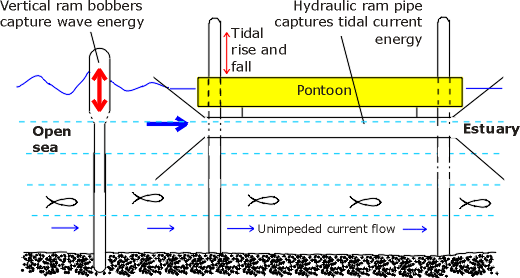
Figure 3. This side view through the barrier illustrates how two different types of rams are employed. First the vertical bobbers capture wave energy, then an array of horizontal hydraulic ram pipes capture tidal current energy.
The pipes are designed to capture tidal energy on incoming and outgoing tides.
How the ram bobbers absorb wave energy
The bobbers have two overlapping chamber sections. On the upstroke the chamber expands sucking air in. On the down stroke, the air is compressed. A nozzle directs the compressed air onto the blades of a turbo-generator unit.

Figure 4.
(a) The upper chamber section rides up on the crest of a wave, drawing air into the expanding volume of the chamber.
(b) After the crest passes, the bobber becomes top heavy, with the excess weight compressing the trapped air.
The compressed air is stored in a smoothing reservoir then passed through nozzles onto the blades of a turbo-generator.
Slight water seepage at the overlap between the two chamber sections allows the mean height of the upper chamber section to alter with tide level.
In order to capture more wave energy and increase the air pressure, pairs of hydraulic ram bobbers are linked to passive bobbers.
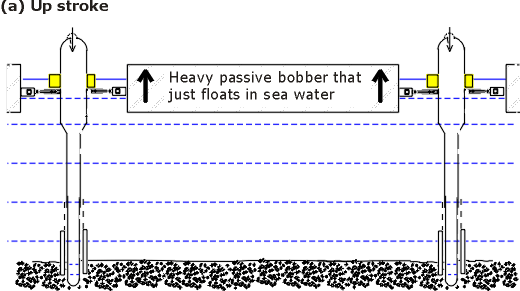
Figure 5. This view, from inside the estuary shows a passive bobber riding up, on the crest of a wave with two ram bobbers.
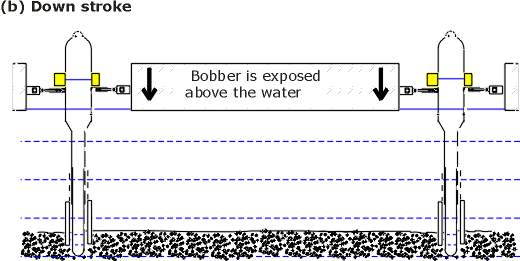
Figure 6.
When the crest passes, the passive bobber is left suspended. The weight of its exposed section increases the pressure on the air inside the hydraulic ram bobbers.

Figure 7. Side view through a passive bobber.
The pattern of alternate passive and hydraulic bobbers is extended to create a long length of barrier.
The couplings between the hydraulic ram and passive bobbers are a standard nautical design that allows the hydraulic bobbers to move out of phase. This enables the barrier to cope with waves that vary in height along their lengths and with waves that approach the barrier at an angle.
How the hydraulic ram pipes work:
Background In 1797, Joseph Montgolfier, the inventor of the hot air balloon built a hydraulic ram pump, capable of pumping stream water uphill.
Stream water was channelled through a downhill pipe and intermittently brought to a halt by closing a spring operated exit valve. This caused a sudden massive increase in water pressure, allowing a fraction of the water to be pumped uphill.
The law of conservation of energy has to be obeyed. Uphill pumping can only be achieved by allowing some of the water to dribble out of the pump as “waste.”
Two hundred years later, the design is still widely used. For details see http://science.howstuffworks.com/question318.htm
We have modified the ram pump concept, using the horizontal flow of tidal currents, instead of the downhill flow of stream water.
In our design, the upper layers of the tidal current water flow through long horizontal pipes and is suddenly forced to a halt. The resultant rapid increase in hydraulic pressure is used to generate jets of high velocity compressed air. These jets are directed on to the blades of the same turbo-generators as the ram bobbers.
- a) The air induction phase.
During this phase water is flowing through the pipe and air is being drawn
into a compression chamber.
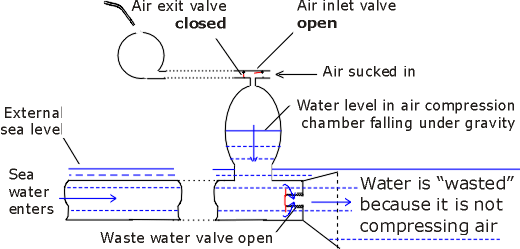
Figure 8. Tidal current water flows through horizontal pipes, 10+ metres in length. At the instant shown, the water is leaving the pipe, via a waste valve.
- b) Compressed air discharge phase.
Water is diverted into the compression chamber, compressing the air.
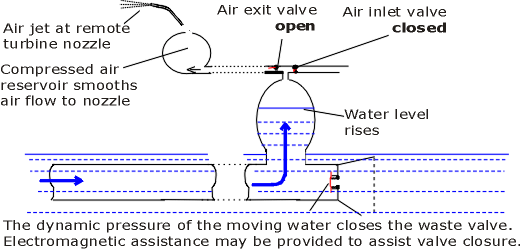
Figure 9.The flowing water snaps the waste valve closed. This diverts water into the air compression chamber. Air is compressed and driven into the air reservoir.
- c) A design that
(i) Captures energy in both tide direction
(ii) Discharges water through side valves to reduce operating cycle time
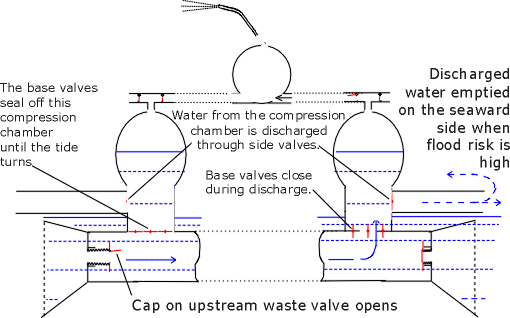
Figure 10. In order to exploit the tidal flow in both directions, waste valves and air compression chambers are added to both ends of the hydraulic ram pipes.
To avoid visual clutter, the simplest versions of the design have been illustrated. In reality, closed circuit compressed air systems will be used, with the air being partitioned from the corrosive sea water by pistons or bellows.
Floating bird sanctuaries
Shallow draught floating barriers will only tap off a small fraction of the tidal energy. To capture a greater fraction of the energy a series of barriers can be built inside an estuary. Some of these could double up as floating bird sanctuaries.
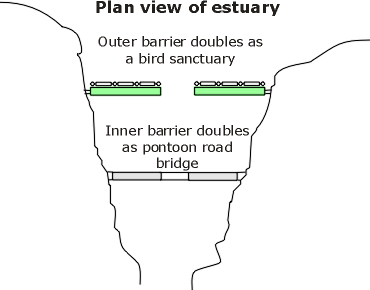
Figure 11. Plan view, looking down on a pair of barriers across an estuary. The outer line of wave energy capturing bobbers help protect the nesting areas from storm waves.
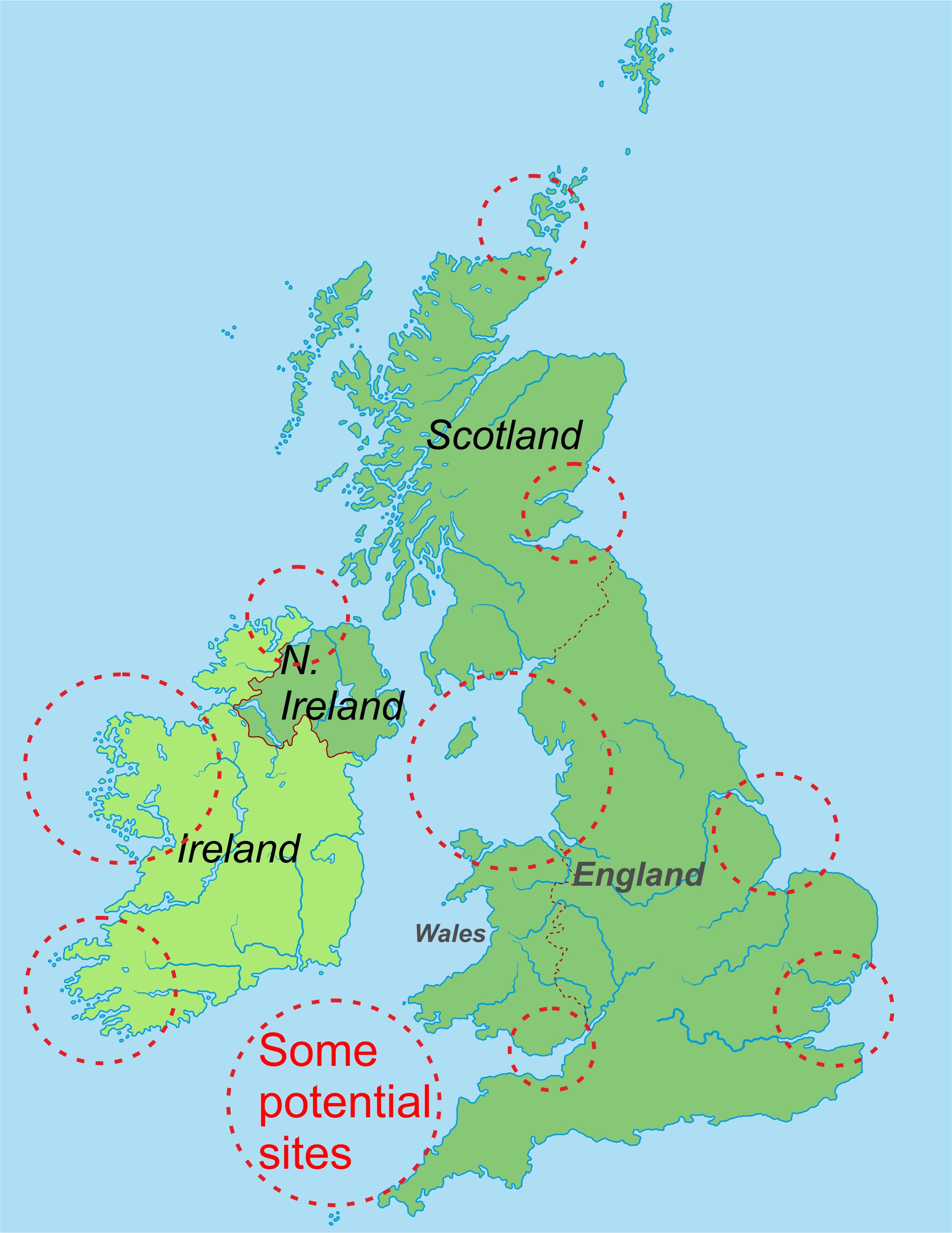
Figure 12. Could Britain and Ireland meet their electricity needs using floating bird sanctuaries?
Engineering skills developed during the North Sea oil boom will enable us to handle ambitious projects in deep water.
Barriers with easy access to the existing electricity distribution grid would be developed first. At a later date, when underground superconducting cables become commercially viable, barriers could be developed in remote areas.
Peak electricity demands in mainland Europe occur at different times to the UK and Ireland. Exporting green energy could become a profitable industry.
For a discussion on the ornithological benefits of nesting rafts visit www.rspb.org.uk/ourwork/conservation/advice/rafts
Hydraulic ram barriers: A summary of key benefits
- The design incorporates features that allow the barrier to harness both tidal current and sea wave energy.
- Typical wave and tidal flow rates are one or two orders of magnitude lower than those required to drive turbo-generators efficiently. The design overcomes this problem without using gears by using ram effects to generate jets of high velocity air, to turn the turbine blades.
- A single turbo-generator unit can be powered by jets of high velocity water from both wave and tidal current sources.
- The air jets are cool. Injection moulded plastics and adhesives can be used extensively in the construction of the turbines, reducing manufacturing costs and salt water corrosion problems.
- If a decision is made to incorporate wind turbines into the support posts for the hydraulic ram pipes, their design can also be simplified by converting their support towers into compressed air storage tanks. Air can be pumped into the tanks, then drawn off as required, to help drive the turbo-generators. The cost of adding submarine hull type reinforcement to the towers will be offset by the elimination of the need for each tower to possess its own generator unit.
- The wind turbines would preferably be vertical axis and covered with fine mesh wire cages, to prevent injuries to bats or birds.
- The design allows the free movement of marine traffic at all times.
- Bed load movement of sediment will not be greatly effected, so the impacts on wild life should be minimal.
- Battery and hydrogen powered vehicles will play a significant role in future transport systems. Excess power generated by barrier systems could be used for overnight battery charging and generating hydrogen by electrolysis.
- Drawing energy from the tidal currents will cause some drop in high tide levels and extracting energy from the waves will reduce their erosive power. These features will help to protect settlements inside the barrier from the higher sea levels and more violent waves likely to result from global warming.
- Studies in the aftermath of the Boxing Day Tsunami show that mangrove swamps cam mitigate the enormous energy of tsunami waves when they hit land. www.ejfoundation.org/pdf/tsunami_report.pdf
The floating tidal barrier could mimic the action of a mangrove swamp by raising sections of decking whenever surge waves are predicted.

Figure 13.
Coastal settlements across the globe are coming under increasing threat of flooding, thanks to global warming. Some areas such as Hong Kong are also under significant threat from tsunami waves. http://environment.newscientist.com/article/dn12544-tsunami-risk-for-hong-kong-and-macao.
The competition
Over the last twenty five years, there has been increasing interest in tidal flow schemes for generating electricity without building dams.
The great attractions of all these schemes are that they involve relatively low civil engineering costs, there is no disruption to shipping and the environmental impact is minimal.
Existing designs tend to be similar to the various types of wind turbines, but with the water current flow driving the turbine blades instead of air. These designs are reviewed at www.cyberiad.net/library/pdf/bk_tidal_paper25apr06.pdf
There are two drawbacks to the existing designs:
(i) Each turbine requires its own dedicated generator.
(ii) The turbine blades rotate far too slowly to drive the generators efficiently, so each turbine also needs a gearbox.
In contrast, the design discussed on this web page is simple but taps into more types of renewable energy resources. It captures tidal flow, bobbing wave and optionally wind energy, storing it as potential energy possessed by compressed air.
Compressed air can be moved at least a hundred metes through pipes without significant energy loss, so a small number of large turbo-generator units can be placed a hundred metres or further apart, along the barrier, to process all of the energy stored in the compressed air. The turbine nozzles will direct jets of air at high velocity onto the turbine blades, allowing the turbines to rotate rapidly, eliminating the gear box requirement.
Flood protection specific examples
- a) Bangkok, Thailand
The following section was written before the 2011 monsoon floods in Thailand
Smith Dharmasaroja, chairman of the Thai Committee for National Disaster Warning Administration predicts, “Bangkok will be under sea water in the next 15 to 20 years.” Sound bites, New Scientist, page 12, 27 October 2007.
The risk of flooding is greatest at high tide during the monsoon season, when the cities Chao Phraya River is in flood and the monsoon winds from the South are driving in storm waves.
The conventional engineering solution to this type of problem is to build massive Dutch style sea walls to separate the city from the sea and the river. But this would completely destroy a major tourist attraction that is an essential part of the character of the city; the vista from the sea of its ancient temples.
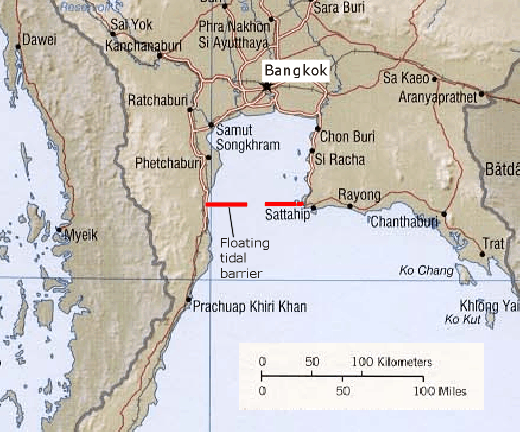
Figure 14, A more elegant solution.
A hydraulic ram barrier built across the Gulf of Thailand, approximately 90 km South of the city would provide marine flood protection without impeding the monsoon outflow of the Chao Phraya River. It would also produce as much energy for Thailand as two or more nuclear power stations, depending on the fraction of the tidal and wave energy processed.
One or more gaps in the barrier would allow the continuous flow of marine traffic.
- b) Great Yarmouth, UK
In November 2007 the people of Great Yarmouth were put on high flood alert. They were lucky, maximum sea levels were a few cm lower than predicted, but it was a close run thing.
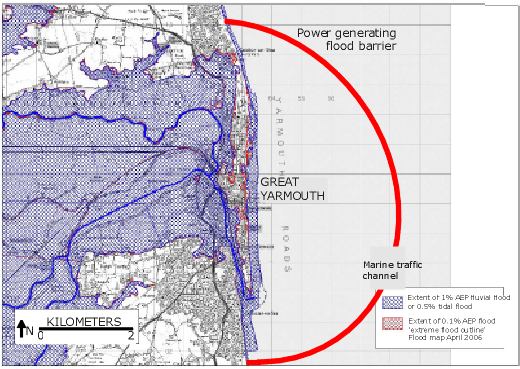
Figure 15. A hydraulic ram barrier could protect the town, while earning its keep generating electricity. Depending on the depth of the barrier and the mean amplitude of the waves, a power output of 10-100 MW per km is estimated. For comparison, Sizewell B nuclear power station further down the coast generates an output of 1100 MW.
The barrier could become a tourist attraction, reviving the Victorian seaside pier experience.
For a sharper view of the flood zone map visit www.environment-agency.gov.uk/commondata/acrobat/flood_risks_pp6579_1158392.pdf
Tidal currents circulate round exposed coastlines such as at Yarmouth, but in and out of tidal estuaries. So, if a ram barrier system is being evaluated purely for power generation purposes, without the benefits of coastal settlement protection being factored in, estuary systems are a first choice.
Interested?
We welcome international enquiries from potential partners, both commercial and academic. We also welcome comments from environmental groups. Please contact us if you would like to open discussions.
Links to other Cheshire Innovation proposals, for improving the environment:
- Water plus Power (Warp) generators. Power generators that converts low grade heat, including waste heat from industrial processes into electricity.
Brine can be distilled to drinking water as a by-product.
Solar powered Warp generators covering 1.6% of the World1s deserts could meet all of our current primary energy needs. - 2. Cryocoolers, low temperature refrigerators. These could be used to improve the efficiency of a wide range of electrical devices and reduce long distance power transmission costs. In conjunction with the recently discovered magnesium diboride superconductor, they could form the basis for superconducting pipelines, moving liquid hydrogen and electricity from remote Warp generators to city centres.
- 3. A transport Internet. A radical proposal for cutting the number of vehicle miles driven, without car owners losing their freedom to drive. Please go to the following page on our innovation dedicated web site. http://website.lineone.net/~billcourtney/Theme%205%20Transport%20Internet.htm
